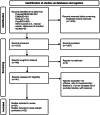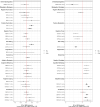Emotion dysregulation in bipolar disorder compared to other mental illnesses: a systematic review and meta-analysis
- PMID: 37842774
- PMCID: PMC10951413
- DOI: 10.1017/S003329172300243X
Emotion dysregulation in bipolar disorder compared to other mental illnesses: a systematic review and meta-analysis
Abstract
People with bipolar disorder (BD) often present emotion dysregulation (ED), a pattern of emotional expression interfering with goal-directed behavior. ED is a transdiagnostic construct, and it is unclear whether it manifests itself similarly in other conditions, such as major depressive disorder (MDD) or borderline personality disorder (BPD), or has specific features in BD. The present systematic review and meta-analysis explored ED and adopted emotion regulation (ER) strategies in BD compared with other psychiatric conditions. PubMed/MEDLINE, EMBASE, Scopus, and PsycINFO databases were systematically searched from inception to April 28th, 2022. Studies implementing validated instruments assessing ED or ER strategies in BD and other psychiatric disorders were reviewed, and meta-analyses were conducted. Twenty-nine studies yielding multiple comparisons were included. BD was compared to MDD in 20 studies (n = 2451), to BPD in six studies (n = 1001), to attention deficit hyperactivity disorder in three studies (n = 232), to anxiety disorders in two studies (n = 320), to schizophrenia in one study (n = 223), and to post-traumatic stress disorder in one study (n = 31). BD patients did not differ from MDD patients in adopting most adaptive and maladaptive ER strategies. However, small-to-moderate differences in positive rumination and risk-taking behaviors were observed. In contrast, patients with BPD presented an overall higher degree of ED and more maladaptive ER strategies. There were insufficient data for a meta-analytic comparison with other psychiatric disorders. The present report further supports the idea that ED is a transdiagnostic construct spanning a continuum across different psychiatric disorders, outlining specific clinical features that could represent potential therapeutic targets.
Keywords: Bipolar disorder; borderline personality disorder; emotion dysregulation; emotion regulation; major depressive disorder.
Conflict of interest statement
G.F. has received CME-related honoraria or consulting fees from Angelini, Janssen-Cilag, and Lundbeck; I.G. has received grants and served as a consultant, advisor, or CME speaker for the following identities: ADAMED, Angelini, Casen Recordati, Ferrer, Janssen Cilag, and Lundbeck, Lundbeck-Otsuka, Luye, SEI Healthcare outside the submitted work;
G.A. has received CME-related honoraria or consulting fees from Janssen-Cilag, Lundbeck, Lundbeck/Otsuka, and Angelini, with no financial or other relationship relevant to the subject of this article.
A.d.B. has received research support from Janssen, Lundbeck, and Otsuka and lecture fees for educational meeting from Chiesi, Lundbeck, Roche, Sunovion, Vitria, Recordati, Angelini, and Takeda; he has served on advisory boards for Eli Lilly, Jansen, Lundbeck, Otsuka, Roche, and Takeda, Chiesi, Recordati, Angelini, and Vitria; A.S. is or has been a consultant/speaker for Abbott, Abbvie, Angelini, AstraZeneca, Clinical Data, Boehringer, Bristol-Myers Squibb, Eli Lilly, GlaxoSmithKline, Innovapharma, Italfarmaco, Janssen, Lundbeck, Naurex, Pfizer, Polifarma, Sanofi, Servier, and Taliaz; E.V. has received grants and served as a consultant, advisor, or CME speaker for the following entities: AB-Biotics, AbbVie, Angelini, Biogen, Boehringer-Ingelheim, Celon Pharma, Dainippon Sumitomo Pharma, Ethypharm, Ferrer, Gedeon Richter, GH Research, Glaxo-Smith Kline, Janssen, Lundbeck, Medincell, Novartis, Orion Corporation, Organon, Otsuka, Rovi, Sage, Sanofi-Aventis, Sunovion, Takeda, and Viatris, outside the submitted work; A.M. has received grants and served as a consultant, advisor, or CME speaker for the following entities: Angelini, Idorsia, Lundbeck, Pfizer, and Takeda, outside of the submitted work. All the other authors have no conflict to declare.
Figures


References
-
- Ambrosi, E., Arciniegas, D. B., Madan, A., Curtis, K. N., Patriquin, M. A., Jorge, R. E., … Salas, R. (2017). Insula and amygdala resting-state functional connectivity differentiate bipolar from unipolar depression. Acta Psychiatrica Scandinavica, 136(1), 129–139. doi: 10.1111/acps.12724 - DOI - PMC - PubMed
-
- APA. (1994). Diagnostic and statistical manual of mental disorders (4th ed.). Arlington, VA, US: American Psychiatric Publishing, Inc.
-
- APA. (2000). Diagnostic and statistical manual of mental disorders (4th ed., text rev.). Washington, DC: American Psychiatric Publishing, Inc.
-
- APA. (2013). Diagnostic and statistical manual of mental disorders (5th ed.). Washington, D.C.: American Psychiatric Publishing, Inc.

